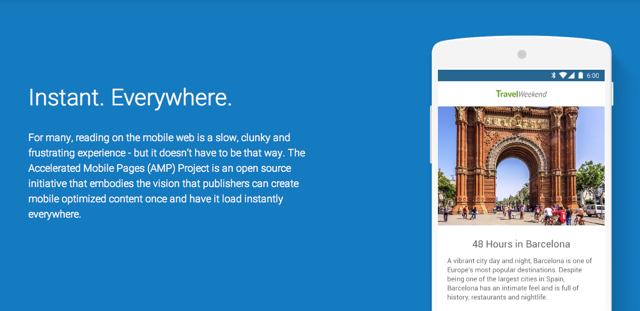Google to Speed Up the Web with Open Source AMP Initiative
February 15, 2016
Google is readying an attempt to reinvent the mobile Web with its Accelerated Mobile Pages (AMP) Project, which has taken just nine months to develop and launch. AMP, a response to proprietary platforms such as Facebook’s Instant Articles and Apple’s News, is an open source platform that dramatically speeds the loading of Web pages, in part by caching content on the cloud. By the time AMP launches, Google will also allow publishers to track analytics, sell ads and put paywalls in place.
According to AdAge, part of the problem is that the average Web page has expanded from 2 to 10 megabytes, making it time-consuming to load. At the outset, several dozen publishers signed onto AMP, but now, says Google executive Richard Gingras, “hundreds if not thousands” have joined in.
Gingras also reports that Google “will favor AMP sites over others with the same search score in the results it shows consumers” and that AMP articles will be accessible from “Google search, Twitter, Pinterest, LinkedIn or, potentially, anywhere online.”
“Talk is one thing, but delivering on that talk is another,” said Gingras. “The depth of collective collaboration that has happened here has been historical.” Among the approximate 20 AMP-approved ad tech vendors is New York-based Kargo, which works with The New York Times, Washington Post and Hearst.
Kargo president Ryan McConville reports that many publishers felt “they didn’t innovate fast enough for desktop and that they got left behind.” Now, he says, they’re trying every platform that comes along, including Snapchat Discover, Facebook Instant Articles and AMP. “But it doesn’t mean they’re really happy about it,” he said. “They are just trying because they don’t want to miss the bus as it’s leaving a station.”
Hearst CTO Allen Duan describes being on so many platforms as “a continuous evolution of distribution,” with a list of partners that “has been growing immensely.” Although the company is forced to hire more staff, he adds, readership has also grown. Hearst is “excited about delivering video through AMP in the near future, and seeing how that plays out,” said Duan.
Washington Post director of product Julia Beizer puts it another way. “We don’t see it as an ‘or,’ we see it as an ‘and’,” she said. “Our fundamental belief is that experience will always win. Consumers will gravitate to experiences that load quickly. We have been really excited to work with Facebook, Apple and Google — there are opportunities in each of them.”


No Comments Yet
You can be the first to comment!
Sorry, comments for this entry are closed at this time.